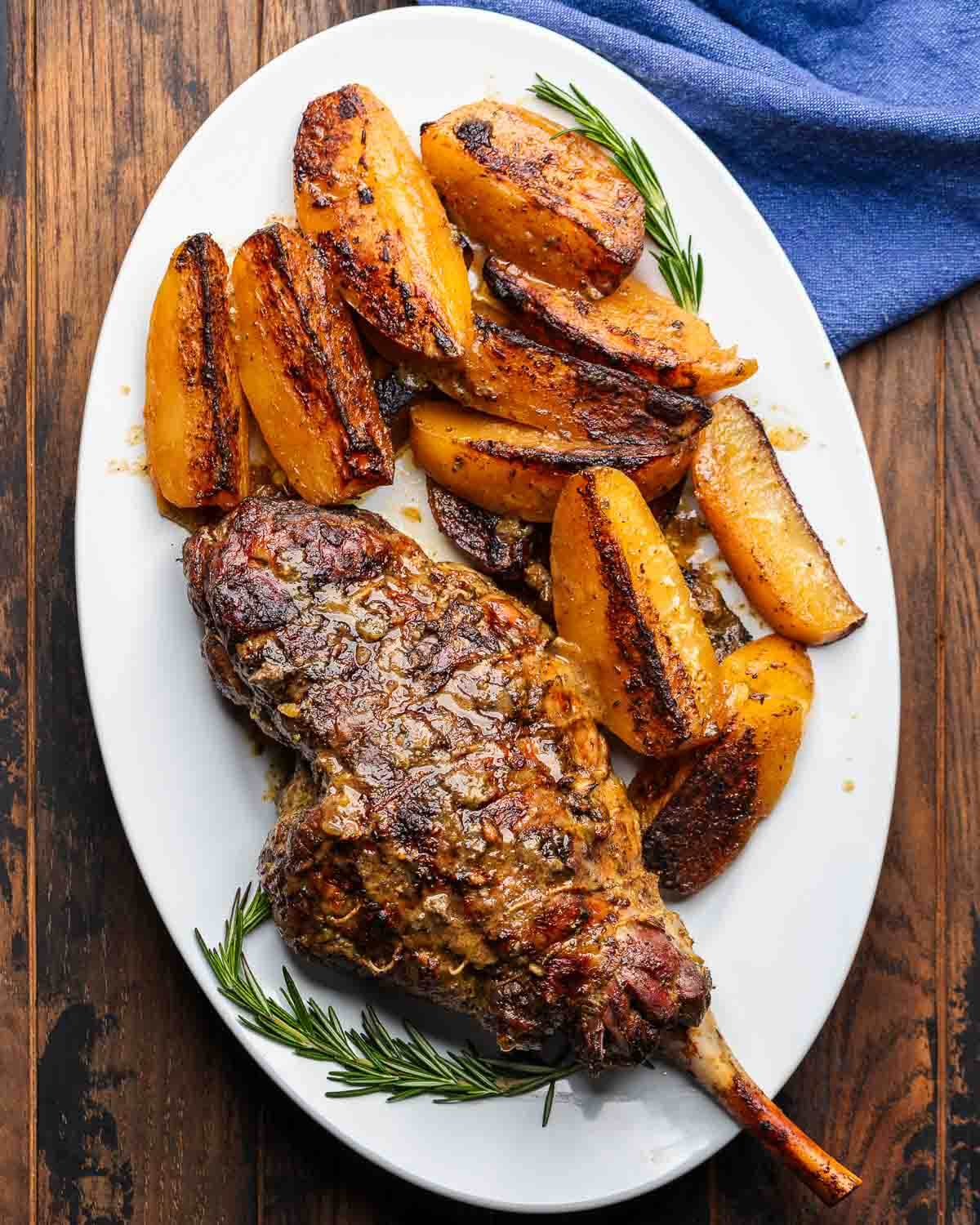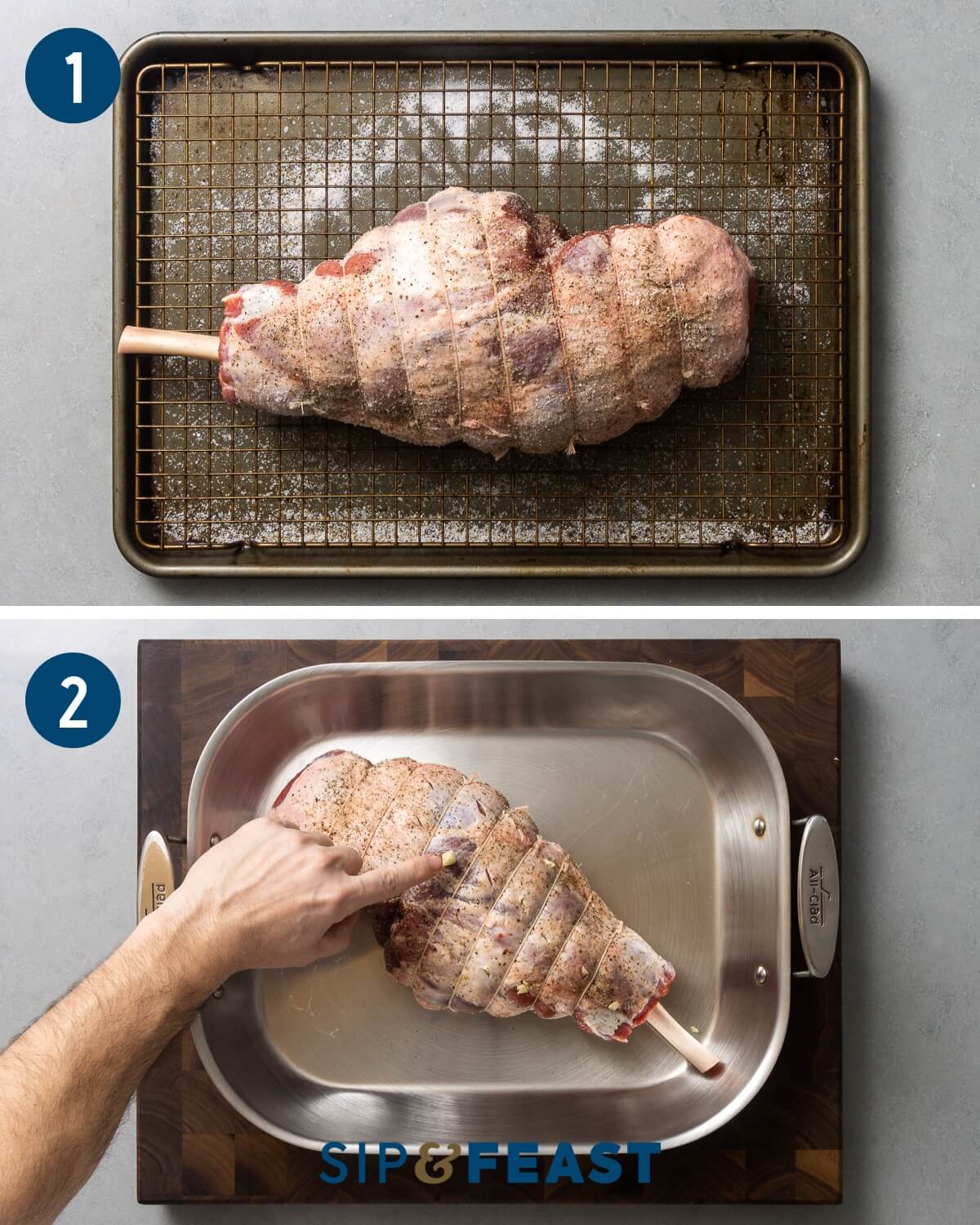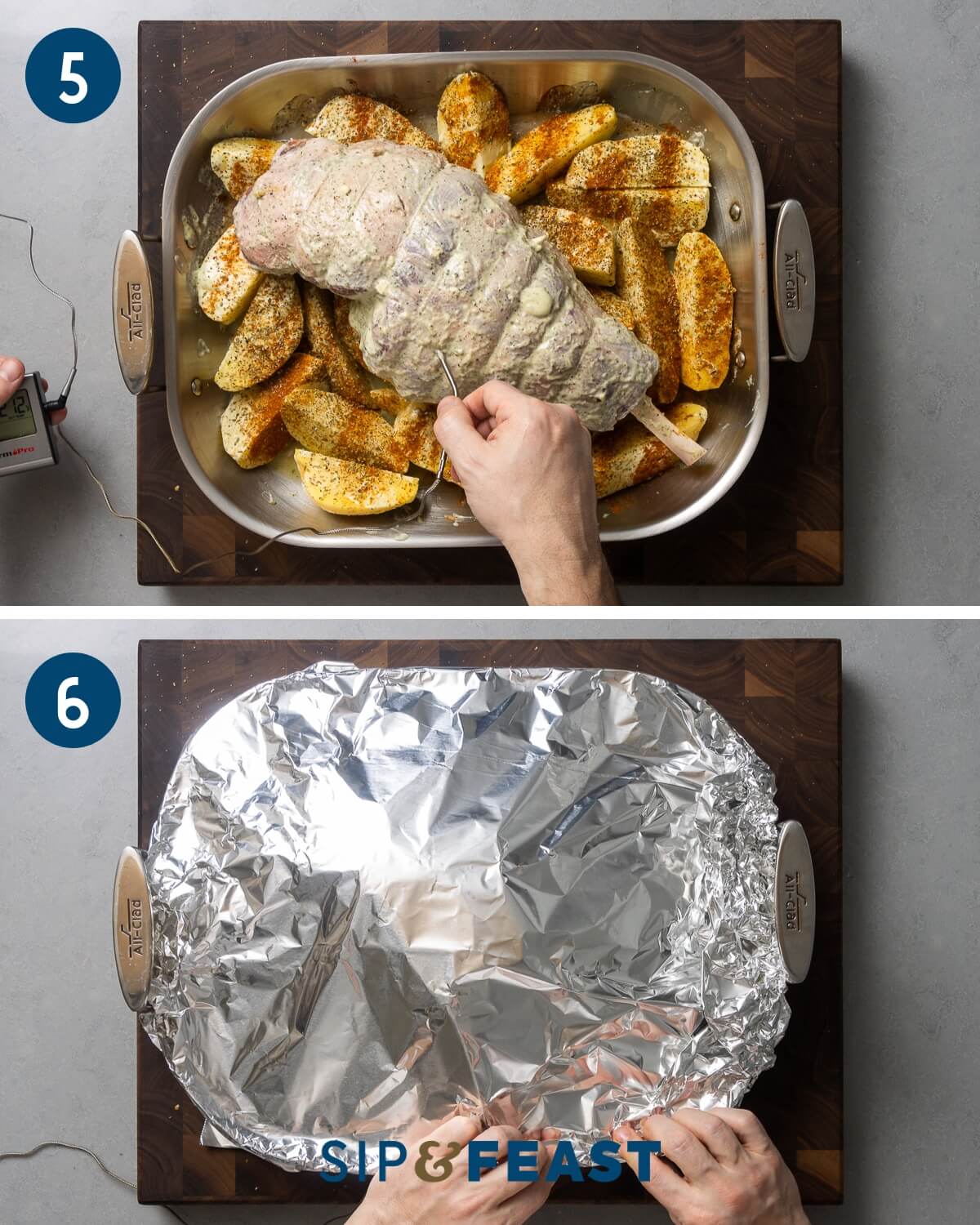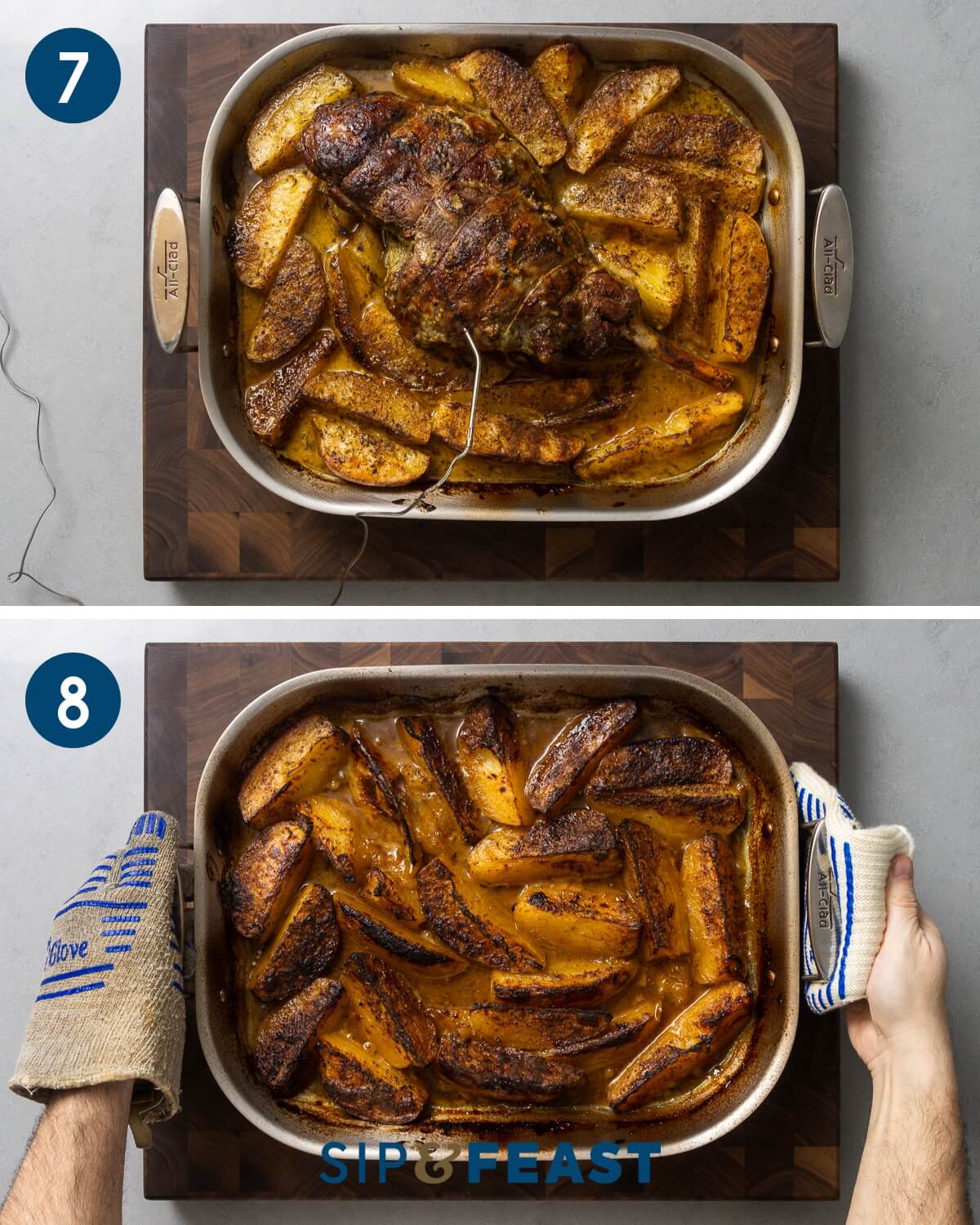There are few things better than Greek-style leg of lamb. It’s slow-roasted until tender with lemon, rosemary, and the most delicious potato wedges you’ve ever had. The perfect meal for Easter, or anytime you’re in the mood for a truly incredible, low-maintenance meal.

This post may contain affiliate links. Our disclosure policy.
When it comes to lamb, there are two ways to prepare it: medium to medium-rare like this boneless leg of lamb, or long and slow-roasted until fall-apart-tender like this Greek leg of lamb with lemon and potatoes.
Because it’s slow-roasted it doesn’t require much maintenance making it ideal for holidays and gatherings.
Since the potatoes are roasted in the same pan, similar to Greek lemon chicken and potatoes, they soak up all the wonderful flavor of the lamb and the lemon-rosemary-oregano sauce.
The lamb and potatoes are served with a simple yet delicious ladolemono sauce that ties everything together and adds even more flavor.
This Greek-style leg of lamb and potatoes is great alongside roasted broccoli, green beans in tomato sauce, Greek salad, or baked asparagus with cheese and breadcrumbs.
And if you’re a fan of Greek flavors, give my Greek Beans and Sausage and Shrimp Saganaki recipes a try!
Recipe Ingredients
All ingredients for this recipe are shown in the pic below and special notes are made in this bulleted list to assist you.

- Lamb. This recipe is for a 4 1/2 to 5 pound bone-in leg of lamb and includes salt and pepper to do a dry brine. Instructions to scale the brine for a different weight are below in the recipe notes. This recipe would be even better with a lamb shoulder, although it can be hard to find a full lamb shoulder here in the US.
- Potatoes. I recommend using Yukon golds and buying them individually so you can select the largest potatoes available. This will yield the long wedges you see in the photographs below.
- Chicken stock. If possible, use homemade chicken stock as you’ll have better control over sodium levels. You can also use a stock made from low-sodium chicken base.
- Herbs. Rosemary is used during the roasting process and dried Greek oregano is used for both the roasted potatoes and the finishing lemon sauce. If you can’t find Greek oregano, you can use regular dried oregano.
- Onions. These are optional and aren’t included in the print recipe below. If you like the addition, roughly chop 1-2 medium onions and toss with the potatoes.
See the recipe card for full information on ingredients and quantities.
How to make it
Each number corresponds to the numbered written steps below.
- If you bought from a butcher the leg was most likely trimmed, but if there is a very thick layer of fat you will want to trim off some of it. You do want fat on the leg and it should look similar to pic 1 below. Season the lamb with the dry brine of 2 tablespoons of Diamond Crystal Kosher salt and 1 teaspoon of black pepper. Place the lamb on a wire rack-lined baking sheet and refrigerate, uncovered, overnight. (Photo #1)

- 1 hour before roasting, remove the lamb from the fridge. Preheat the oven to 325f and set the rack to the middle level. Cut 5 garlic cloves into pointed slivers and make slits in the lamb, pressing each garlic sliver into the slits. (Photo #2)
- To a blender add 2 tablespoons of fresh rosemary leaves, 2 tablespoons of honey, 1 tablespoon of Dijon mustard, 1/3 cup of fresh lemon juice, 10 cloves of garlic, and 3/4 cup of olive oil and blend until smooth. Pour half the marinade over the lamb and use your hands to run it all over. Let the lamb sit and absorb the marinade for at least 30 minutes before roasting. (Photo #3)

- Cut 3 1/2 pounds of large Yukon gold potatoes into large wedges and place them in a roasting pan large enough to accommodate them and the lamb. Pour the remaining marinade over the potatoes and mix well, then add 1/2 cup of low-sodium chicken stock to the pan. Season the potatoes with salt and pepper, 1 teaspoon of paprika, and 1 tablespoon of dried Greek oregano. (Photo #4)
- Place the lamb, fat side up, on top of the potatoes. You can insert a digital oven-safe thermometer into the thickest part of the lamb if you like, but it’s more important to cook the lamb to the proper texture instead of temp. More on that below. (Photo #5)

- Cover the pan tightly with foil and place in the oven to roast for 3-4 hours or until the meat easily pulls away from the bone and shreds. Test with a fork at the 3 hour mark and if it is still tough, cover and roast for another 1 hour. The temp of the lamb might get up to 180-190f during the stage. (Photo #6)
- Once the lamb is fork tender, turn up the heat in the oven to 450f and remove the foil. Allow the leg of lamb to roast for another 10-12 minutes or until lightly browned. (Photo #7)

- Remove the lamb and place on a platter tented with foil. Place the potatoes back in the oven and continue to roast until most of the liquid has evaporated, about 20-30 minutes. While the potatoes roast, make the ladolemono sauce by combining 1/4 cup of lemon juice, 1 teaspoon of lemon zest, 2 teaspoons of Dijon mustard, 1 cup of extra virgin olive oil, 2 cloves of garlic (turned into a paste), 2 teaspoons of dried Greek oregano, 1 teaspoon of salt, and 1/2 teaspoon of black pepper. Whisk or blend the ingredients, taste test, and adjust salt as needed. (Photo #8)
- Place the potatoes on a platter with the lamb and use a ladle to degrease the remaining pan sauce. (Photo #9)

- Pour the pan sauce on top of the lamb and potatoes and serve with the Greek ladolemono sauce. The lamb can be sliced in it’s largest section and near the bones the meat can be pulled and shredded. Enjoy! (Photo #10)
Top tips
- Brining the lamb. I highly recommend dry brining the leg of lamb the night before making as it yields a more juicy roast. If you don’t have time for the dry brine, you can skip this step, season the lamb, and marinade.
- Cooking the lamb. A good rule of thumb is 3-4 hours (or 37-45 minutes per pound) tightly covered at 325f. Check it at the 3-hour mark and see if the meat pulls away from the bone without much resistance. Stick a fork into the meat and twist the fork. If the meat shreds it is done. If not, roast it covered for another 30-60 minutes. Cook the lamb for texture and not temp, though you can use a thermometer as shown above to help guide you. The final internal temp will be around 185-200f which is the optimal temp for slow-roasted lamb. Cooking to this stage allows for a shreddable consistency near the bone. If you prefer your lamb medium, roast it until the temperature hits 130-135f and allow it to rest until it reaches 140f, or for medium-rare, remove it from the oven at 125-130f.
- Fat side up. Placing the fat side of the lamb up to roast will yield superior results as it allows the fat to drip down and further flavor the lamb and potatoes.
Want To Save This Recipe?

Roast recipes you’ll love
Whether you’re planning a holiday gathering or a special dinner at home, these are the tried and true roast recipes I love to make and know you will too.
If you’ve enjoyed this Slow-Roasted Greek Leg of Lamb with Potatoes Recipe or any recipe on this site, give it a 5-star rating and tell us about it in the comments below.
We strive to satisfy a number of learning styles. If you are someone who prefers to learn by watching, you can find most of our recipes on YouTube and our Facebook Page.
Greek Slow-Roasted Leg of Lamb with Potatoes

Ingredients
For the dry brine
- 1 4 1/2-5 pound leg of lamb trimmed of excess fat
- 2 tablespoons Diamond Crystal Kosher salt
- 1 teaspoon black pepper
Remaining ingredients
- 3 1/2 pounds Yukon Gold potatoes cut into large wedges
- 15 cloves garlic divided
- 2 tablespoons fresh Rosemary leaves
- 2 tablespoons honey
- 1 tablespoon Dijon mustard
- 1/3 cup fresh lemon juice
- 3/4 cup olive oil
- 1 tablespoon dried Greek oregano
- 1 teaspoon paprika
- 1/2 cup low-sodium chicken stock
For the ladolemono sauce
- 1/4 cup lemon juice
- 1 teaspoon lemon zest
- 2 teaspoons Dijon mustard
- 1 cup extra virgin olive oil
- 2 cloves garlic paste
- 2 teaspoons Greek dried oregano
- 1 teaspoon salt plus more to taste
- 1/2 teaspoon black pepper
Want To Save This Recipe?
Instructions
Salt (dry brine) overnight
- Season the lamb with salt and pepper and then place the lamb on a wire rack lined baking sheet and refrigerate, uncovered, overnight.
Marinate and roast
- Remove the roast from the fridge 1 hour before roasting. Preheat oven to 325f and set the rack to the middle level.
- Cut 5 garlic cloves into pointed slivers. Make slits in the lamb and press the garlic into those slits.
- Place the rosemary, honey, Dijon mustard, lemon juice, remaining garlic, and olive oil into a blender and blend until smooth. Pour half of the marinade over the lamb and rub it all over. Let the lamb absorb the marinade for at least 30 minutes before roasting.
- Place the potato wedges into a large roasting pan. Pour the remaining marinade all over the potatoes and mix well. Pour the chicken stock into the roasting pan. Season the potatoes with salt to taste and sprinkle the paprika and oregano all over.
- Place the lamb, fat side up, on top of the potatoes. Cover the pan tightly with foil and roast in the oven for 3 hours. Check the lamb with a fork. The meat should easily pull away from the bone and should be tender throughout. If not, cover and roast for another 30-60 minutes and check again.
- Once tender, turn the heat to 450f and remove the foil. Roast for another 10-12 minutes or until the roast is lightly browned. The final internal temp of the lamb might hit 190-200f. It is more important to cook the lamb until tender and shreddable than worrying about the exact internal temp!
- Remove the lamb to a platter and tent with foil. Continue to roast the potatoes until most of the liquid has evaporated (about 20-30 minutes).
- Place the potatoes onto the platter with the lamb. Degrease the remaining pan sauce and pour the sauce on top of the lamb and potatoes. Serve lamb with ladolemono sauce. Enjoy!
For the ladolemono sauce
- Blend or whisk the ingredients and season with salt to taste.
Notes
- Salting (dry brining) the lamb overnight is recommended.
- Brine at a 1% ratio of salt to total leg of lamb weight. A 5-pound leg of lamb weighs 2270 grams so it needs ~22 grams of salt which equals roughly 1 1/4 tablespoons of table salt. When using Kosher salt you will need to use more tablespoons because a tablespoon of Kosher salt weighs less than a tablespoon of table salt. See the table below:
- 1 Tablespoon of Table salt = ~19 grams
- 1 Tablespoon Morton Kosher salt = ~15 grams
- 1 Tablespoon Diamond Crystal Kosher salt = ~10 grams
- A note about doneness – This Greek-style lamb is supposed to be well done and shreddable. If you want medium-rare lamb, aim for 130°F or about 20 minutes per pound. Use an oven-safe thermometer for accuracy.
- Leftovers can be saved for up to 3 days in the fridge. To reheat, wrap the lamb in foil and cook in the oven at 350f until warm.
Nutrition
Nutrition information is automatically calculated, so should only be used as an approximation.
Follow Me







Our break from lasagna for Easter dinner. It was delicious, and our house smelled amazing. This just might become our Easter dinner going forward. The lamb fell off the bone, potatoes melted in your mouth, sauce brought everything together. My Greek cousin said it reminded her of her childhood.
We’re so happy to hear that, Gerrie! Thanks for the great comment!
Just made this recipe for Easter and it came out great! Honestly, I really don’t care for lamb but my boyfriend loves it. This recipe was spot on. He loved it! And although I still don’t really care for lamb, with your recipe, it had a really good flavor and was extremely tender. I will definitely be making it for him again.
I saved all the fat drippings and broth and used some of it the next day to mix in with the broth when I made rice for a leftover lamb, rice, veggie casserole.
I discovered tour YouTube channel about a month ago. So far I have made 3 or 4 of your recipes. All have come out great but this one by far was the best!
Thanks for all the work you put into your YouTube channel as well as your website. It makes a big difference.
We’re so happy to hear you’re enjoying the recipes, Karen!
I decided to cook a leg of lamb for Easter. After looking at a few recipes, I chose this one because it was a slow cooking recipe, making it easier to manage temperature and because it was greek and I’m going to Greece in two months. I bought a 10 pound boneless leg. I slow roasted it for 7 hours and it turned out one of the best meats I’ve ever done. Plus, everyone loved the sauce and asked for the recipe. We didn’t use the potato recipe since my sister-in-law makes the best mashed potatoes, and I added a carrot dish and an asparagus dish. It was an Easter feast to remember!
We’re so happy you and your family enjoyed the lamb, Mary! Thanks for the comment!
Made the lamb and potatoe scalloped. Came out great and also tried your way with the ham nice change. Thank you.
So happy you enjoyed, Leslie!
Hello, is it possible to marinate this for longer than 30 mins? What if I want to marinate it overnight?
Hi Naz, you can definitely marinate overnight. Hope you enjoy!
Can i freeze the left over leg of Lamb?
Hi Lisa, yes, you can.
Hello! I woul d like to make this as part of ur Easter brunch, but oven space is an issue. Could you make it the day before and warm it for guests? TY so much- I love your recipes!!
Hi there, yes, you can make it the day before and rewarm. Hope you enjoy!
My first time making a leg of lamb, great instructions. At 6.5 pounds, it took ~4.75 hours to get the meat tender and another 20 to finish potatoes.
Don’t skip the Ladolemono sauce! Really makes the flavor burst. Going to make this again for Easter!
We’re so happy you enjoyed it, Briana!
I made this a few days ago and it was phenomenal. I was working with a 2.7kg (6ish pounds) leg of lamb. Cooked on low for 5 1/2 hrs under foil, then up high for 4mins. Removed the lamb and then kept the potatoes in for another 45 mins. The meat was so tender and delicious and my son said they were the best potatoes I’ve ever made – and I make some great roast potatoes.
Your video and the additional food were extra helpful.
Can’t wait to make it again!
So happy to hear this, Lisa!
I’m confused on the cook time for the potatoes are they supposed to cook for so long?
Hi Charmin, the potatoes cook the entire time the lamb is roasting and in addition to that. I recommend watching the video if you still feel confused as that will clearly explain everything.
I made this for Christmas dinner and people lost their minds…so flavourful, tender…Best lamb and potatoes ever. Thank you for the clear recipe.
We are so happy you and your guests enjoyed, Cindy! Thanks for the comment!
Is this recipe for a bone in leg of lamb or boneless leg of lamb. I can’t wait to make this. Sounds delicious
Hi Donnalee, this recipe is for a bone-in leg. We do have a boneless leg of lamb recipe here: https://www.sipandfeast.com/roasted-boneless-leg-of-lamb/
I used a boneless leg of lamb and it came out great.
I have a boneless leg of lamb that’s 2.25 pounds. I dry brined it last night and cut off the large layer of fat underneath but I’m wondering if it’s better to slow roast it as this recipe suggests or if I should follow the recipe u did previously for boneless leg of lamb? The flavors sound awesome in this recipe but I don’t want to mess up the lamb, what do u suggest doing?
Hi Jacy, either recipe is fine! The lamb recipes are very different – this one yields well done slow roasted lamb, while the other is cooked more medium-rare. It really depends on how you want the final results to be.